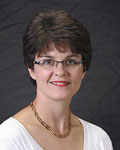March 31, 2013
What is your Sign… Language?
 By Dr. Molly Parker
By Dr. Molly Parker
Audiologist
Parker Audiology, PC
When I was a child, people would notice that I wore amplification, and they would ask me if I knew sign language. Their speech would suddenly get louder, and they talked to me like I did not understand English. I felt foolish when they did that. At the same time, I always wanted to know sign language, because I figured that people who signed must be the best spellers since they were always spelling words with their fingers, or writing down words. Spelling was very hard for me, because I could not hear the sounds in the words, and I had to memorize the words to get them correct on my tests. I figured if I had to sign, I would have the innate ability to spell everything correctly.
Boy was I wrong! People with hearing loss tend to be far behind educationally. Whereas the average adult American reads at the 8th grade level, the average adult deaf individual reads at a 3rd grade level. One study indicates that nearly 45 percent of deaf students do not graduate from high school and only 5 percent graduate from college. Additionally, there is 42 percent unemployment and 70 percent dependence on Medicaid among the the deaf. (http://dallashearingfoundation.org/facts/). Historically, parents who have kids with significant hearing impairment may not have found out their child is hearing impaired until their child was age 3-5 years old, depending on the hearing loss. We currently have technology to discover hearing loss during early infancy. But once the diagnosis is complete, the treatment is another matter. Selecting an appropriate hearing aid provider, fitting with hearing aids, and then following through with amplification is another matter. Parents must impose consistent use of hearing aids, and provide a language rich environment. Patient interaction with appropriate spoken language and/or signed language are key in hearing impaired kids learning language successfully.
With educational professionals’ expertise, parents are often required to select speech therapy and a mode of communication (spoken versus signed), including which kind of sign language to teach their child. Most parents have no background in hearing loss or modes of communication. To give you an example, some more common examples include Signed Exact English (SEE), American Sign Language (ASL), or Cued English. SEE means that for every word AND every word ending there is a sign. For example, the phrase “I have a brown little dog” would have six signs. Whereas in ASL, it may have 31/2 signs. And Cued English may be spoken English but with a signed letter cured around the head indicating that you said “D” for Dog instead of “H” for Hog. There are other systems available, but these are most familiar to me.
Eventually, deaf kids grow up and become deaf adults who have their own deaf traditions, communication strategies, and culture. The Quad-Cities has a vibrant, healthy deaf community, that is grateful for work, and always happy, patient and willing to talk with and teach anyone who is willing to learn sign language. But, I am told that they, like me, don’t want to be treated like know-nothings. Hearing loss does not mean that you are dumb and mute. This adult population is street-smart, observant, and hard working and communicative. Written messages are welcome. Clear speech means that words are said clearly but not exaggerated.
Filed Under: Health & Wellness
Tags: Aid Provider, Amplification, Audiologist, Audiology, Deaf Students, Educational Professionals, Graduate From High School, Hearing Aid, Hearing Aids, Hearing Impairment, Innate Ability, Learning Language, Molly Parker, Patient Interaction, People With Hearing Loss, Rich Environment, Sign Language, Spellers, Spelling Words, Spoken Language
Trackback URL: https://www.50pluslife.com/2013/03/31/what-is-your-sign-language/trackback/


